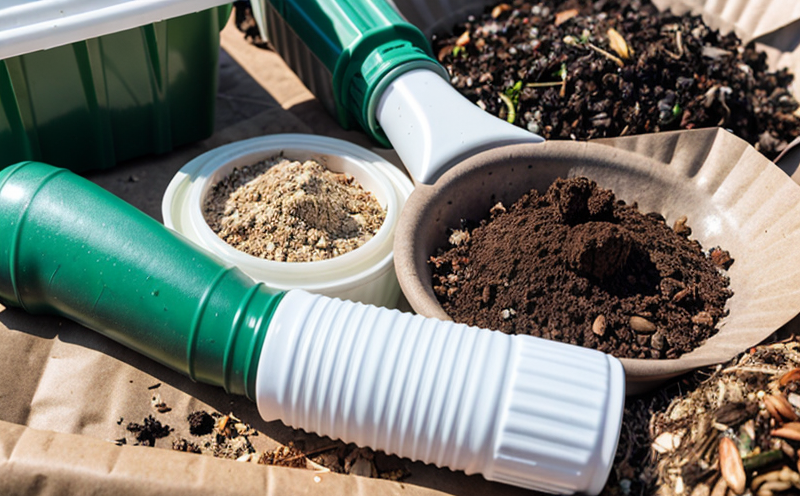ASTM D7832 Nutrient Release Potential of Organic Waste
The ASTM D7832 standard provides a method to evaluate the nutrient release potential (NRP) of organic waste materials. This test is crucial for understanding how quickly and effectively nutrients are released from compostable or biodegradable packaging, mulches, and other similar products into soil environments. The NRP measurement helps ensure that these products meet environmental standards for compostability and biodegradability.
The ASTM D7832 method involves the use of a controlled environment incubator to simulate natural conditions under which organic materials decompose. This includes maintaining specific temperature, humidity, and oxygen levels over an extended period (typically 14 days). The test aims to quantify the release of nitrogen, phosphorus, potassium, and other key nutrients into leachate. Released nutrients are then analyzed using standard analytical techniques.
The importance of this testing cannot be overstated in today’s world where sustainable waste management practices are increasingly emphasized. For instance, many municipalities require that packaging used within their jurisdictions is compostable or biodegradable to minimize landfill burden and promote recycling efforts. Compliance with ASTM D7832 ensures that products meet these stringent requirements.
Compliance officers and quality managers can use the results from this test to verify whether a product will indeed break down in natural conditions, thus supporting their sustainability goals. R&D engineers benefit greatly as well since they gain insights into how different formulations affect nutrient release rates, which can guide further development towards more efficient compostable materials.
Additionally, procurement teams involved in selecting suppliers for sustainable products would find value in ASTM D7832 compliance because it serves as a reliable indicator of environmental friendliness. By ensuring that their supply chain adheres to this standard, companies can demonstrate leadership in responsible waste management and contribute positively towards global sustainability initiatives.
In summary, the ASTM D7832 test plays a critical role in verifying organic wastes’ ability to decompose properly while simultaneously releasing essential nutrients back into soils. Its rigorous methodology ensures accurate results that are invaluable for stakeholders across various sectors including manufacturing, agriculture, and environmental science.
Applied Standards
The ASTM D7832 standard is widely recognized and applied internationally as a benchmark for evaluating the nutrient release potential of organic waste materials. It specifies precise procedures to ensure consistent results across different laboratories regardless of location or equipment used during testing.
This international standard includes detailed instructions on sample preparation, incubation conditions, monitoring protocols, and analytical methods required to determine nutrient concentrations in leachate produced by tested samples after a specified period (14 days). Compliance with ASTM D7832 guarantees that tests conducted follow best practices recognized globally within the industry.
By adhering strictly to these guidelines, laboratories can produce reliable data which stakeholders like quality managers and R&D engineers rely upon when making decisions about product formulations or regulatory compliance. The standard also facilitates communication between parties involved in waste management projects by providing a common language based on established procedures.
Scope and Methodology
The scope of ASTM D7832 encompasses the evaluation of nutrient release potential from organic waste materials under controlled conditions that simulate natural decomposition processes. This includes determining nitrogen, phosphorus, potassium, and other key elements released into leachate during the testing period.
To begin with, samples must be prepared according to specified guidelines which may involve cutting them into uniform pieces if necessary. These samples are then placed into containers designed for incubation at specific temperatures (e.g., 30°C) and humidity levels (e.g., 75% relative humidity). Oxygen availability is also carefully controlled during this phase of the test.
The incubation period lasts for 14 days, after which time nutrient concentrations are measured using established analytical techniques such as colorimetric assays or ion chromatography. Results obtained from these analyses provide insight into how efficiently nutrients were released over the testing duration and whether they meet predetermined criteria set forth by relevant regulations.
It is important to note that ASTM D7832 does not specify particular limits for nutrient release; instead, it focuses on providing a standardized approach to measuring such parameters. This allows laboratories flexibility when interpreting results in light of local or project-specific requirements.
Quality and Reliability Assurance
The quality and reliability assurance measures associated with ASTM D7832 testing are stringent to ensure accurate, reproducible results that meet the needs of stakeholders across various industries. Laboratories performing these tests adhere strictly to specified protocols outlined in the standard to maintain consistency and precision.
For instance, sample preparation involves meticulous techniques aimed at ensuring uniformity among samples being tested. This step minimizes variability caused by differences between individual specimens, thereby enhancing overall test accuracy. Careful attention is also paid to incubation conditions such as temperature, humidity, and oxygen levels to mimic realistic environmental factors influencing nutrient release.
During the testing process, rigorous quality control checks are implemented throughout each stage—from initial sample collection through final analysis—to catch any discrepancies early on before they impact results significantly. Additionally, laboratories participating in ASTM D7832 tests typically participate in proficiency programs offered by recognized organizations to further validate their methods and ensure reliability.
Reliability assurance extends beyond just laboratory procedures; it also encompasses robust documentation practices that trace every aspect of the testing process. From detailed logs recording environmental parameters during incubation to comprehensive records documenting sample handling, all steps are meticulously documented for transparency and accountability.





